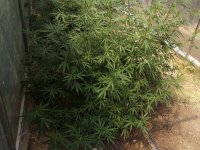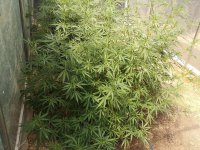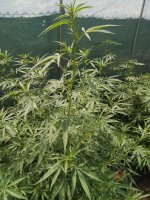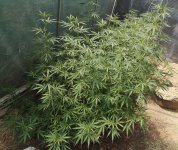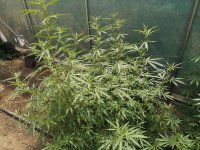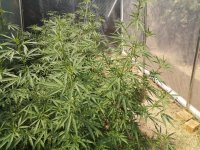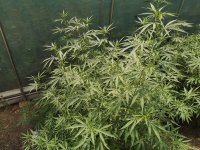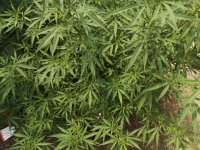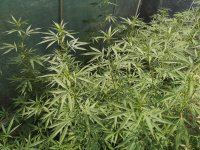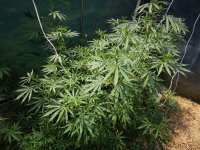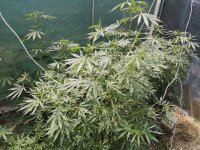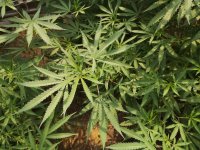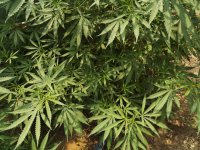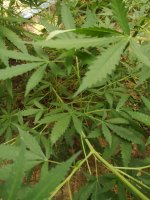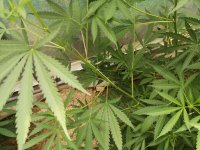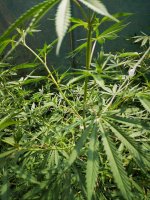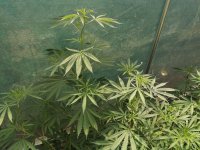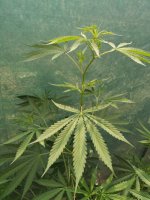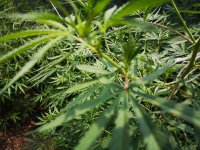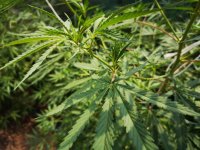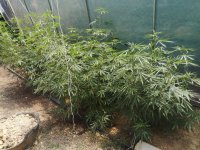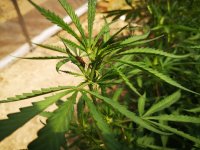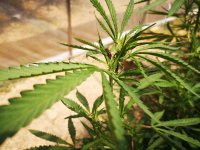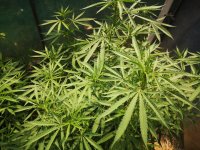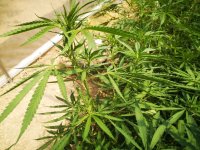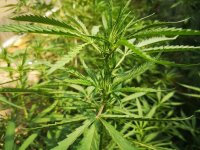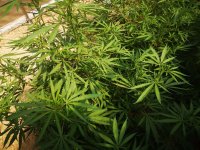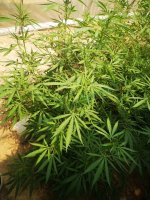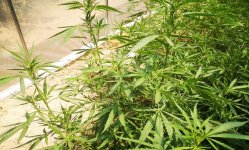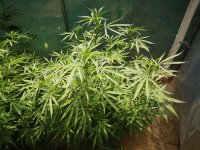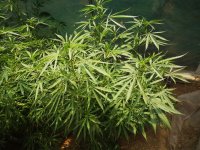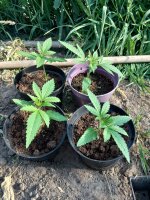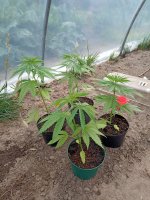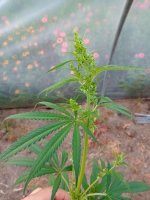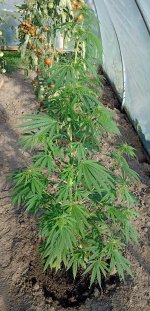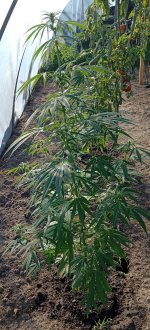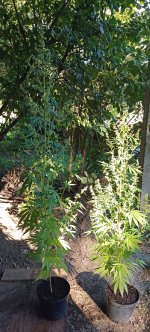Indian Landrace Exchange strains
- Thread starter Thread starter dubi
- Start date Start date
North51
Active member
Hopar Valley update 1: Ik heb 5 zaden geweekt op 4 juli en binnen 30 uur waren er al 4 zaden open. en binnen 48 uur was de vijfde ook open. het zaadje dat er het langst over deed om te ontkiemen, deed er meer dan een week over om zijn kop boven de grond te krijgen. en daar stopte het met groeien. zo is het leven. de reden dat ik pas in juli met deze planten ben begonnen, is omdat ik niet wil dat ze te groot worden. als ze niet volledig kunnen rijpen bij N51°. (21 juni is de langste dag) Dan hebben ze wellicht nog een geschikte maat voor binnen. maar ik zou ze liever in mijn kas houden. en plant ze in de grond als de bloei goed is begonnen. de complexiteit van de grond kan je niet evenaren met turf of cocos enz... op bijgevoegde foto is de Hopar-vallei +/- 16 dagen oud. en twee foto's van 8/11. de volgende update komt wanneer ze hun geslacht laten zien. Ik ben nieuwsgierig. en het is leuk om planten te hebben die een heel andere geur hebben.
Attachments
North51
Active member
Hopar valley update 1: I soaked 5 seeds on the 4th of July and within 30 hours 4 seeds were already open. and within 48 hours the fifth was also open. the seed that took the longest to germinate took more than a week to get its head above the ground. and that's where it stopped growing. that's life. the reason I didn't start these plants until July is because I don't want them to get too big. if they cannot fully ripen at N51°. (June 21 is the longest day) Then they may still have a suitable size for indoors. but I would prefer to keep them in my greenhouse. and transplant them to the ground when flowering has got off to a good start. you cannot match the complexity of the soil with peat or coco etc ... the attached photo shows the Hopar valley +/- 16 days old. and two photos from 8/11. the next update will come when they show their gender. I'm curious. and it's nice to have plants that have a completely different scent.
What’s the smell?Hopar valley update 1: I soaked 5 seeds on the 4th of July and within 30 hours 4 seeds were already open. and within 48 hours the fifth was also open. the seed that took the longest to germinate took more than a week to get its head above the ground. and that's where it stopped growing. that's life. the reason I didn't start these plants until July is because I don't want them to get too big. if they cannot fully ripen at N51°. (June 21 is the longest day) Then they may still have a suitable size for indoors. but I would prefer to keep them in my greenhouse. and transplant them to the ground when flowering has got off to a good start. you cannot match the complexity of the soil with peat or coco etc ... the attached photo shows the Hopar valley +/- 16 days old. and two photos from 8/11. the next update will come when they show their gender. I'm curious. and it's nice to have plants that have a completely different scent.
North51
Active member
hello to everyone, update 2: we are almost a month further. and things have progressed rapidly with the four Hoparvalleys. the first signs of pre-flowering that I could see without a magnifying glass was on August 24th. during that period we have +/- 14 hours of sunshine. I had tried to take pictures of the very small premature flowers. but my camera is not good enough for that. in one month they have more than doubled in length. they have been transplanted to 7L pots and they will remain there for a while until these pots are well rooted. they are only given organic food, watered daily and no pruning techniques are used. and perhaps I will plant them with their roots in the earth. but that depends on the progression during flowering and the weather conditions. I have two females and two males. And they have narrow leaves for a pure indica. I'm not used to see this.


Attachments
That would depend on altitude and latitude. The Hopar Valley from Gilgit-Baltistan flowers for 8-9 weeks.Somebody any idea when the cannabis harvest starts and end in Pakistan?
Attachments
North51
Active member
Thanks,That would depend on altitude and latitude. The Hopar Valley from Gilgit-Baltistan flowers for 8-9 weeks.
D
Deleted member 534625
I know this thread is old but I was curious if anyone has grown this out.RED KUMRAT
Red Selection from the Kumrat Valley, Khyber Pakhtunkhwa, featured a tall/wispy structure upto 7ft tall with minimal side branching. The flowers were quite airy and lose covered in resin and many bracts already opening up to disperse the seeds. It carried a strong piney stench, along with aromas resembling industrial adhesive.
A truly beautiful example of a primordial landrace variety, which hasn't been systematically cultivated or domesticated, by human beings but only used as a herb procured directly from the wild. Hence, these populations have been surviving completely on their own in this harsh terroir for the longest time by letting the environment take complete control of their evolutionary path. Where, the environmental pressure of the terroir gradually shapes the plant populations overtime to best fit their ecological habitats, imperative for long term survival.
Kumrat Valley, is located towards the northernmost fringes of the Khyber Pakhtunkhwa around 35N, with an average floor elevation of 2000 meters. The Valley lies in the lesser known kohistan region which is inhabited by mostly Kohistani tribes.
Due to a combination of high latitude position and high altitude the onset of snow comes as early as late October to early November, which brings the valley to a halt until April when the snow clears.
Kumrat Valley is located towards the south East of Chitral and hence falls around the eastern foothills of the Hindu Kush mountain range traversing into Afghanistan.
Kumrat Valley, doesn't have any planned cultivation of cannabis at all, and all the cannabis populations in the valley are intact in their primordial form, completely unaffected from any domestication efforts.
The local variety grows up to be an extremely thin, wispy up to 5-7 ft tall plants, with disperse bract flower structure. The seeds are ejected from the bracts automatically at different times during the flowering period similar to other wild varieties we have seen in the past. However, the size and the density of the resin glands is exceptional as expected from a cannabis population adapted to an extremely cold (semi-tundra) climate.
These primordial landrace populations represents the actual Hindu Kush highland variety which has been taken by farmers, travellers, collectors and so many others to a variety of different habitats from it's own. To be then domesticated, bred, selected and turned into something more productive to human beings.
The overall lack of vigor in the plants, can be seen from a lesser root mass to thin/wispy stems only capable of producing little bud growth.The buds typically feature smaller sized bracts with a short life span, facilitating the self dispersal of the seeds. In the valley, seeds fall on the ground each year to be buried under the snow for at least 4 months before they can sprout up once again in the spring season.
The seeds are typically oblong/pear shaped, tiny and dark in color. The seeds have extremely hard shells, that seems to have developed multiple non permeable layers, which stops the moisture from entering the seed for long periods of time thus delaying the germination until the favourable time of the year, i. e. spring.
The weather around the harvest window gets extremely cold, with a wild swing in the day and night time temperatures. A lot of plants can be seen expressing vibrant hues of purples and reds. The flowering window is only around 8-9 weeks in the valley, which begins from August and closes in the first week of October as the snow comes in. These plants appear similar to the primordial Landrace populations documented in northern Kashmir (Lolab valley) and even from the southern Kashmir region like Srinagar and Pulwama.
Which finishes with an appearance similar to a long flowering variety from lower latitudes, However, the flowering term is significantly shorter (almost half compared to Landraces adapted to temperate regions located at lower latitudes) The buds are much more dense and the resin production is exceedingly better with bigger size of resin glands , especially the capitate-stalked trichomes which are rarely seen on the landrace varieties from hotter (temperate and equatorial) regions.
Bouquet: Strong piney stench, along with aromas resembling industrial adhesive.
High: A wilder population with not so strong but very unique, uplifting and mood elevating effects.
I have not seen any grow reports for that one, yet. It sounds like it has the building blocks to build an heirloom that has excellent cold resistance and other undiscovered properties.
North51
Active member
Hi all,
I planted both women in the ground. the flowers are going well, they are plants with a lot of strength and energy. both men are close to the end of flowering. a man has a height of +/- 1.80 m. this stretched a lot during the beginning of flowering. the other male did not stretch much in the initial stages of flowering. he is a good 40 cm smaller. but has many more flowers. I'm curious about the ending. The smell of the plants is still difficult to describe. they smell like something that is overdue.
I planted both women in the ground. the flowers are going well, they are plants with a lot of strength and energy. both men are close to the end of flowering. a man has a height of +/- 1.80 m. this stretched a lot during the beginning of flowering. the other male did not stretch much in the initial stages of flowering. he is a good 40 cm smaller. but has many more flowers. I'm curious about the ending. The smell of the plants is still difficult to describe. they smell like something that is overdue.
Attachments
North51
Active member
Can you give more details please. About which strain are you talking?Wat voor werk wordt er met deze zaden gedaan?
Is er sprake van reproductie binnenshuis voor seksuele stabiliteit?
I am specifically interested in Kerala GoldCan you give more details please. About which strain are you talking?


